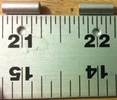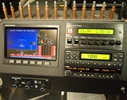


random user submitted photo
Y tail angle
14 posts
• Page 2 of 2 • 1, 2
Y tail angle
racaldwell wrote:Carlos,
I guess you have a fixed probe? I just thought they were all like the one I bought, it is removable. I am thinking it can be clocked in any way. I remember it has o-rings on the end but don't remember if was keyed. It's been too many years since working on the tail. I haven't looked at the probe since then.
Rick Caldwell
Xenos 0057
Hi Rick
No, I have a removable probe as well.
The manufacturer (ESA Systems) recommends that the probe be used always with the TE sensor pointing upwards.
Further, they also recommend that the adapter (the female piece, installed solid inside the stabilator) be installed with the 3 barbed ports pointing upwards, like this
https://www.esa-systems.com/fileadmin/u ... einbau.jpg
That is the reason why I wanted to know the angle of the stabilator with the horizontal, exactly to clock the position of the adapter which is to be rigidly installed inside the stabilator.
Problem solved!
Thanks
Carlos
- Carlos Trigo
- Posts: 154
- Joined: Fri Feb 14, 2020 3:46 pm
Re: Y tail angle
Carlos Trigo wrote:No, I have a removable probe as well.
The manufacturer (ESA Systems) recommends that the probe be used always with the TE sensor pointing upwards.
Further, they also recommend that the adapter (the female piece, installed solid inside the stabilator) be installed with the 3 barbed ports pointing upwards, like this
https://www.esa-systems.com/fileadmin/u ... einbau.jpg
That is the reason why I wanted to know the angle of the stabilator with the horizontal, exactly to clock the position of the adapter which is to be rigidly installed inside the stabilator.
Problem solved!
Thanks
Carlos
Hey Carlos,
When I was researching TE/pitot/static probes I called one of the better known aviation shops specializing in soaring. I asked for the type of combination TE/pitot/static probe you are using. Their response: "Well we'll sell you that if the plans demand it, but we don't recommend it." Why? Those combo probes have very small O rings inside to separate the air flows. IF one of the O rings comes dislodged it might be necessary to REMOVE the probe mount to fix or replace it. Not a fun prospect. I then decided to buy a separate pitot tube (installed in right stabilator) and a separate TE probe (installed in the left stabilator). The static ports were installed on the fuselage sides.
By the way, do you know why they want the probe's barbs to be mounted in a vertical orientation? It all about moisture. If any liquid (rain) enters the probe it will need to travel straight uphill, which it is less likely to do, before entering the tubing which is now running downhill towards your expensive instruments. In my installation the barbs are pointing up enough to keep liquids from entering the tubing (it doesn't need to be straight up).
-- Michael
OneX N169XE
author of the 'Flight Data Viewer'
OneX N169XE
author of the 'Flight Data Viewer'
- XenosN42
- Posts: 412
- Joined: Thu Jul 24, 2014 4:45 pm
- Location: PA, USA
Re: Y tail angle
On our E-Xenos, we installed the 3-port pitot/static/total-energy probe on the tip of the right stabilizer.
Might have been this one, or something similar:
https://www.esa-systems.com/en/products ... -mnicun-1/
Unfortunately, it has proven to be very sensitive to yaw. When oriented with the TE side arm straight up, as recommended, it indicated 500 fpm lift in a left yaw, and 300 fpm sink when yawing right. After testing all orientations, we settled on orienting it 45 degrees left of up, or in-and-up. It is still yaw sensitive but the vario is somewhat usable now.
Might have been this one, or something similar:
https://www.esa-systems.com/en/products ... -mnicun-1/
Unfortunately, it has proven to be very sensitive to yaw. When oriented with the TE side arm straight up, as recommended, it indicated 500 fpm lift in a left yaw, and 300 fpm sink when yawing right. After testing all orientations, we settled on orienting it 45 degrees left of up, or in-and-up. It is still yaw sensitive but the vario is somewhat usable now.
- Xenos59-1/2
- Posts: 1
- Joined: Thu Feb 11, 2021 10:30 pm
Re: Y tail angle
All - TE probes tend to be yaw-sensitive because they use holes drilled on the aft-facing side of the tube and rely on airflow around the tube to create a Venturi effect where the holes are (since TE compensation is usually achieved through the use of a calibrated amount of suction).
When you yaw, you change the relative angle of the wind on the probe, shifting the low-pressure-zone on the back side of the tube to the left or right. Some TE probes use an array of holes to reduce this yaw sensitivity, but they remain less reliable in a slip or skid.
If the probe is too short, it may actually be the flow-field around the stabilizer that is causing those unwanted readings. Given the angled orientation of the “Y” tail stabilizers, that dovetails nicely with the orientation you found to provide more-accurate readings - as that orientation displaces it farther from the extended centerline of the stabilizer chord.
—Noel
(Who’s used the multi-probe system on a couple of sailplanes for several years with no o-ring problems)
When you yaw, you change the relative angle of the wind on the probe, shifting the low-pressure-zone on the back side of the tube to the left or right. Some TE probes use an array of holes to reduce this yaw sensitivity, but they remain less reliable in a slip or skid.
If the probe is too short, it may actually be the flow-field around the stabilizer that is causing those unwanted readings. Given the angled orientation of the “Y” tail stabilizers, that dovetails nicely with the orientation you found to provide more-accurate readings - as that orientation displaces it farther from the extended centerline of the stabilizer chord.
—Noel
(Who’s used the multi-probe system on a couple of sailplanes for several years with no o-ring problems)
- NWade
- Posts: 527
- Joined: Mon Aug 08, 2011 3:58 pm
14 posts
• Page 2 of 2 • 1, 2
Who is online
Users browsing this forum: No registered users and 2 guests







